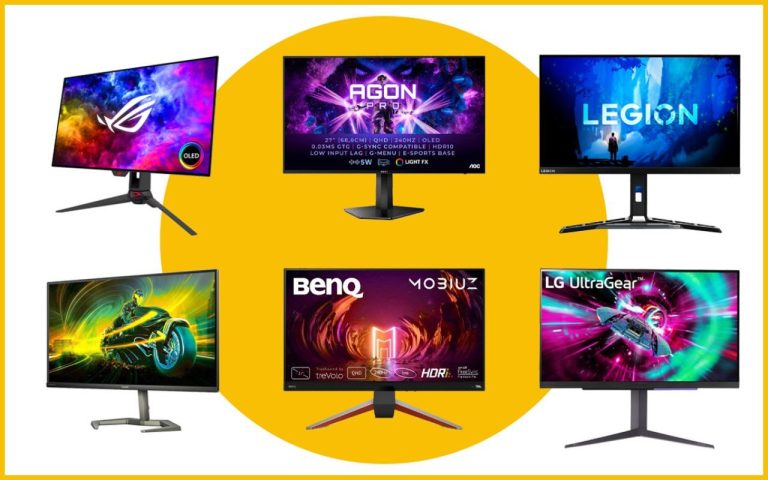What type of monitor is best for gaming?
Your choice is between expensive OLEDs (see below) and more affordable LCDs. There are three main types of LCD monitor, each with their own particular pros and cons.
Older TN (Twisted Nematic) LCD monitors offer great response times, but are often hampered by washed-out colours and narrow viewing angles.
Most gaming monitors today use IPS (In-Plane Switching) LCD panels, which offer higher brightness and better colour fidelity as well as wider viewing angles.
VA (Vertical Alignment) LCD panels sit somewhere between TN and IPS, but are usually poorer when it comes to response times, making them less suitable for hardcore gamers than in-plane switching panels.
Are OLED gaming monitors better?
OLED screens differ from LCD-based types in that they don’t require a backlight and so can display near-perfect blacks (by switching pixels completely off), as well as offering more vibrant colour rendition. OLEDs with higher refresh rates are becoming more common, but are currently still more expensive than similarly fast LCD panels.
Is 1440p good for competitive gaming?
Professional gamers tend to prefer 1080p, for reasons I’ll explain below, but first let’s explain the terms.
The number of pixels used to generate a picture is always expressed in width x height. FHD (Full High Definition) is 1,920 x 1,080 pixels, usually shortened to 1080p.
QHD (Quad High definition – also called 2K) is 2,560 x 1,440 pixels, so it’s usually referred to as ‘1440p’.
There are also UHD (Ultra High Definition) panels, comprised of 3,840 x 2,160 pixels. These are usually called 4K because they’re four times the resolution of high definition.
So why is 1080p better for hardcore gaming? Playing at 1440p or higher looks smoother, but it invariably takes its toll on a graphics card’s ability to deliver a high frame rate. It’s the frame rate that competitive gamers value, since it lets them react more quickly to game events.
What does FPS mean?
Frames Per Second, also known as Frame Rate, varies according to the type of game being played, and signifies how many times a second an image is rendered from the computer’s graphics card to the monitor.
What is refresh rate?
Measured in Hertz (Hz), this indicates how many times per second a gaming monitor can display an image. Traditionally, the standard has been 60Hz, but 144Hz is now becoming more common, with some monitors able to hit 240Hz. These higher refresh rates appeal to hardcore competitive gamers.
Needless to say, your PC and graphics card – and your retinas – need to be up to the job if you want to benefit from a monitor’s faster refresh rates.
What is VRR?
This stands for variable refresh rate, a way of preventing onscreen stuttering and screen-tearing. These defects can happen when the frame rate output of your graphics card fails to match your monitor’s refresh rate. VRR or ‘adaptive sync’ technologies – AMD Freesync and NVIDIA G-Sync are the best known – attempt to match both rates, in order to create a smoother, glitch-free gaming experience.
What is the best screen brightness?
Brightness is measured in cd/m2 (candelas per square metre), also referred to as Nits. How bright you want your gaming monitor to be will depend on a number of factors: the ambient lighting in your room, your personal taste and whether or you’re playing games in SDR (Standard Dynamic Range) or HDR (High Dynamic Range). HDR content needs higher levels of brightness.
In truth, there are very few monitors that offer enough brightness to make the very most of HDR but, as a rule of thumb, 400cd/m2 is the minimum you should be looking for with HDR games. If you’re playing games with mostly SDR content, then 300cd/m2 or even 100cd/m2 will suffice.
What is HDR?
In essence, High Dynamic Range or HDR allows game designers to create visuals that better simulate what you see in real life. HDR does this by preserving more depth, detail and punch in the brightest and darkest parts of an image than SDR (Standard Dynamic Range).
HDR10 is one of the leading HDR standards. HDR10-compliant monitors offer peak brightness levels of a minimum 1,000 cd/m2.
Many PC gaming monitors support HDR10, but others cite compliance with the VESA DisplayHDR standards, in which level 400 is the lowest performance tier and level 1400 is the highest. Anything below level 1000 is likely to be fairly mundane.
What is pixel density?
Pixel density measures the number of pixels per inch (PPI) on a monitor. The more pixels per inch there are, the sharper onscreen text will be, an important consideration if you want your gaming monitor to double up for office use. 100 to 150 PPI is the sweet spot here.
What are DisplayPort and HDMI?
Both these HDR-compatible connections carry all the audio/video signals from your graphics card to your gaming monitor via a single cable. You might have come across HDMI on TVs and soundbars, but DisplayPort is specific to gaming monitors.
Unlike HDMI, DisplayPort also allows you to daisy-chain multiple monitors and so might be a better option for your PC system, depending on your needs.
HDMI 2.1, by the way, offers a higher bandwidth than HDMI 2.0, allowing higher frame rates for 4K gaming. But it isn’t really a must-have at the moment.
